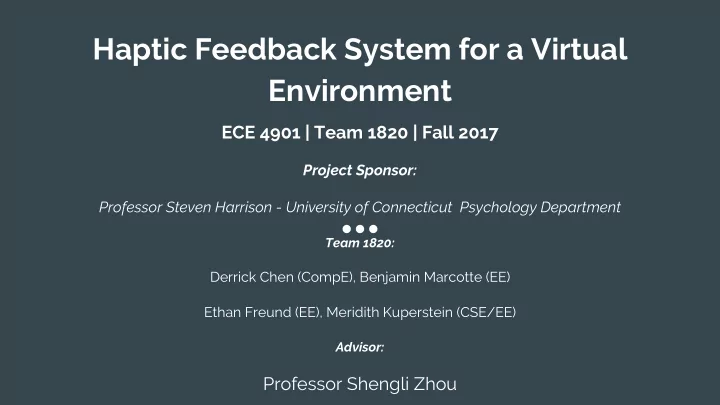

Haptic Feedback System for a Virtual Environment ECE 4901 | Team 1820 | Fall 2017 Project Sponsor: Professor Steven Harrison - University of Connecticut Psychology Department Team 1820: Derrick Chen (CompE), Benjamin Marcotte (EE) Ethan Freund (EE), Meridith Kuperstein (CSE/EE) Advisor: Professor Shengli Zhou
Overview ● Project Overview and Background ● Project Requirements ● Chosen Implementation ● Materials and Techniques Used ● Simulating Physics and Programming ● Current Status ● Future Plans
Haptic Feedback Systems “... Of or relating to tactile sensations and the sense of touch as a method of interacting with computers and electronic devices: smartphones that incorporate haptic feedback [1].” [1] http://www.dictionary.com/browse/haptic
The Project Professor Steven Harrison studies human-object interaction, and wants a 1D ● linear motion haptic feedback system The linear motion system will allow users to simulate frictional forces, and other ● forces, while pushing a real physical blocks in one dimension and will interact with virtual environments, which they can see projected on a screen This system will be used to study how people interact and adapt their motion in ● novel, simulated environments with touch feedback
Linear Haptic Feedback System Will be able to simulate interactions with springs, different surface coefficients of friction, and virtual walls. Force Feedback Virtual Environment Projection
Requirements ● Must handle loads up to 150N ● Feedback delay must be <10ms, or small enough that delay is unnoticeable ● Must have minimal audible noise ● Must have built in safety features ● Must have two blocks that can move either independently of each other or concurrently
Implementation Belt-Driven Motor Braking System F_applied (motor) Force Sensor F_applied (hand) DAQ Sliding Block Applied motor torque CPU Motor Controller Circuit Motor Encoder
Implementation Cons Delay could be a problem ● Delays come from I/O interface, computer processing, and motor operation ○ High cost motors ● Based on torque and control requirements ○ ○ Currently looking at a $2,000 motor system Initial friction may be high ● Friction comes from wheel bearings on cart, wheel to rail friction, internal motor resistance, and ○ pulley friction Sound from metal wheels on a metal rail ●
Materials Used Data Acquisition: Force Sensor: National Instruments USB-6255 DAQ ATI 9105-TW-MINI-58 ● ● ○ 80 analog input & 2 analog output channels ○ Measures force/torque on XYZ axis ±5V or ±10V outputs Handles a lot of force ■ ○ ○ Up to 1.25 MS/s ■ 21000N or 4721 lbs on XY axis 16-bit analog resolution 48000N or 10791 lbs on Z axis ○ ■ ○ Small and compact Computer: 58mm wide & 30mm tall ■ ● Digital Storm Enough processing power for incoming DAQ ○ data USB 3.0 ○ ○ Also, handles display graphics
Potential Materials - Motors Brushless Servo Motors Options: Offer high acceleration/deceleration Kollmorgen Motor ● ● Used in precision applications ○ Ethernet or analog control ● Good torque feedback ○ Precise control of position & velocity ○ StepServo ● Produce little noise ● Ethernet or analog control ○ ○ Clicks on rotation ClearPath Teknic ● ○ Runs on digital frequency/PWM signal Good torque feedback from specifications ○ ■ No access for a sample
Potential Materials - Rails V Slot Rails T Slot Rails Has only one method of implementation Requires additional bearings to be a ● ● ○ Acts as a linear rail linear rail Uses a specific wheel ○ Many different implementations are ● Cheap & modular ● possible Smooth movement along a rail with a cart ●
Where We Currently Are Built Prototype ● Testing different types of motors for ease of use and ‘smoothness’ ● Comparing different rail systems for cost and modularity ● ● After testing, decide on final configuration
System Modeling in Virtual Space Normal Force Simulated Force Equations Spring System: F spring = -k*x Friction: When Input Force > μN, F friction = -μ k N Simulated Force Horizontal User When Input Force < μN, (Friction or Spring) Input Force F friction =-Input Force Weight and Downward User Force
Programming Language ● C++, possibly some Python ○ Compatibility with hardware ○ ● 3D Environment Visually simulates real world physics ○ Obstacles and force fields ○ Currently in pseudo-code phase ● Initial testing will be simplified and from a sample data set ○
Cost Projection Item Cost ($) Test budget 200 Rail Mount System 200-300 Motor System 1500-2500 Computing System 0 (Readily Available) Force Sensors 0 (Readily Available) Data Acquisition System 0 (Readily Available) Total 1900-3000
Future Plans End of Fall 2017 Semester- Make final hardware decision and order parts January 2018- Start the physical build Mid February 2018- Finish first build Mid February 2018- March 2018- Test and redesign End of March 2018- Finish final product
Questions?
Recommend
More recommend